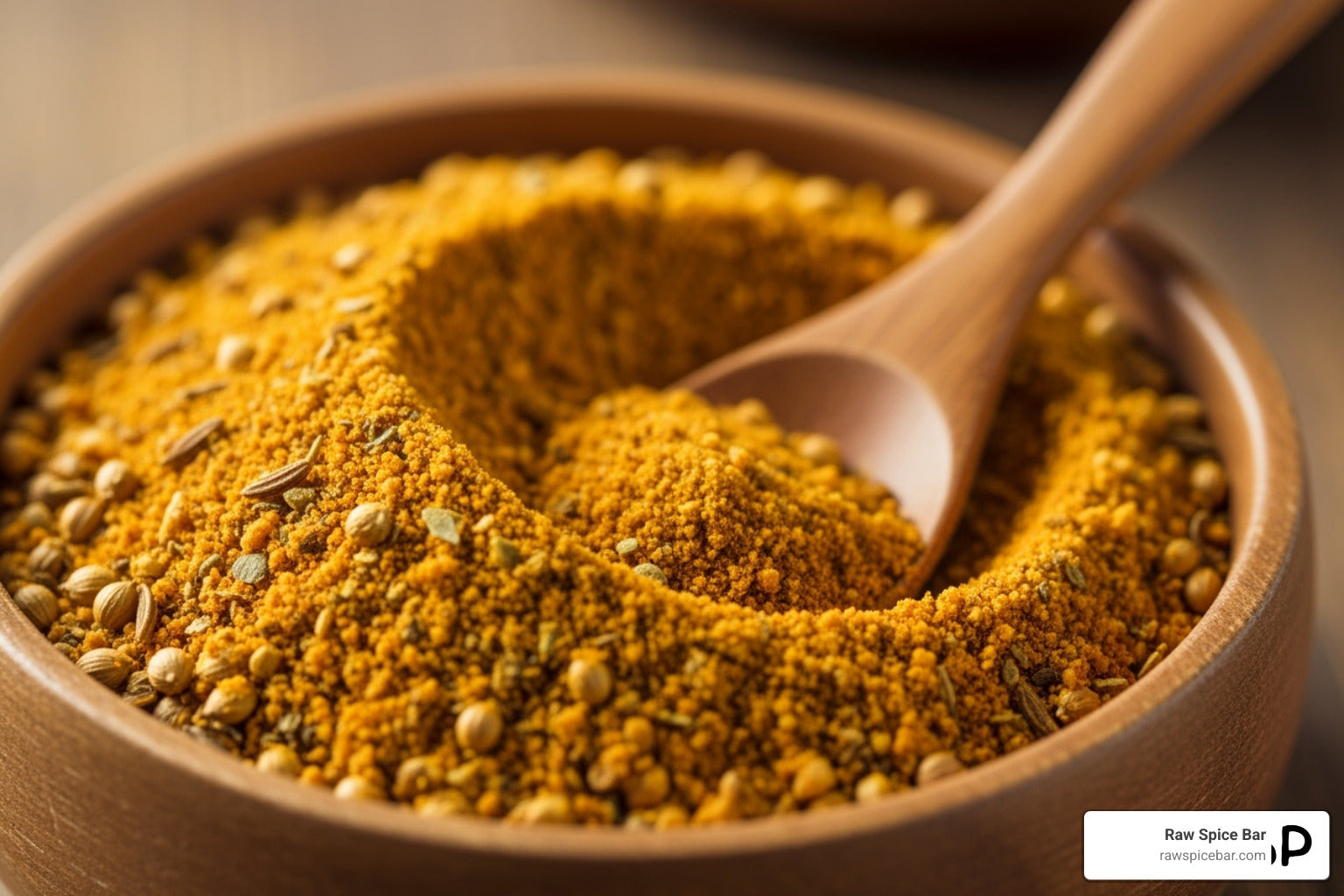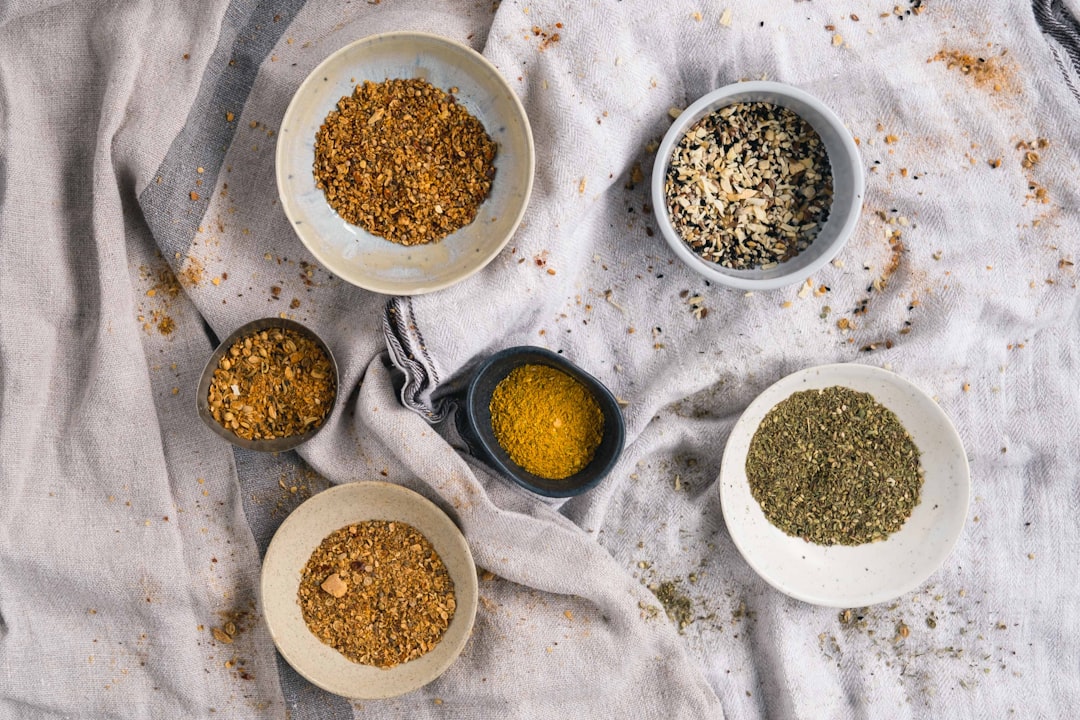Spice Without the Salt: Why Low Sodium Matters
Low sodium fajita seasoning is a flavorful alternative to store-bought packets that can contain up to 300mg of sodium per 2-teaspoon serving. Here's what you need to know:
- Homemade mix contains only 15-37mg sodium per serving compared to 200-300mg in commercial blends
- Key ingredients: chili powder, cumin, paprika, garlic powder, oregano, and cayenne (no salt added)
- Storage life: Up to 6 months in an airtight container
- Usage: 1-2 tablespoons per pound of protein
Following a lower-salt diet doesn't mean sacrificing flavor. Mexican cuisine is often rich in sodium, but making your own seasoning puts you in control of what goes into your food. With a simple homemade blend, you can enjoy the vibrant, zesty flavors of fajitas without the excessive salt that can contribute to high blood pressure and other health concerns.
Store-bought fajita seasonings typically contain not just sodium but also MSG, preservatives, and unnecessary added sugars. By creating your own mix at home, you're not only reducing sodium intake but also eliminating these unwanted additives.
I'm Joseph Rosenblatt, founder of a premium spice blend company where I've spent years perfecting salt-free seasonings, including low sodium fajita seasoning that delivers authentic flavor without compromising health. My experience sourcing global spices and developing recipes has taught me that reducing sodium never means reducing taste.

What Is Fajita Seasoning & Why Sodium Content Counts
Let's talk about that magical dust that transforms ordinary chicken and veggies into a sizzling fiesta! Fajita seasoning captures the heart and soul of Tex-Mex cooking in a simple blend. At its core, you'll find warm chili powder, earthy cumin, vibrant paprika, savory garlic and onion powders, and aromatic oregano. It's this combination that creates that "mmm" moment when fajitas hit your table at a restaurant—or better yet, your own kitchen.
But here's the thing about those convenient store-bought packets: they're absolutely loaded with salt. While a little sodium makes flavors pop, commercial blends go overboard in a big way.
The average American already consumes about 3,400 mg of sodium daily—that's nearly 50% more than the recommended 2,300 mg limit! And if you're managing certain health conditions, doctors often recommend staying under 1,500 mg. When a single 2-teaspoon serving of packaged fajita seasoning contributes up to 300 mg of sodium, you're using 13% of your daily "salt budget" before you've even added a single vegetable!
| Sodium Source | Amount (mg) | % of Daily Value (2,300 mg) |
|---|---|---|
| Store-bought fajita seasoning (2 tsp) | 300 mg | 13% |
| "Lower sodium" commercial blends (2 tsp) | 200+ mg | 8.7% |
| Homemade low sodium fajita seasoning (2 tbsp) | 15-37 mg | <2% |
| Complete chicken fajita meal with store seasoning | 400 mg | 17.4% |
| Complete chicken fajita meal with homemade seasoning | 137 mg | 6% |
Why does this matter? Because excessive sodium isn't just about water retention and that puffy feeling. Over time, it significantly increases your risk of high blood pressure, heart disease, and stroke. The good news? Making your own low sodium fajita seasoning lets you create that perfect flavor harmony without the salt overload.
As we've finded at Raw Spice Bar, understanding spice blends opens up a whole new world of healthier cooking possibilities. Fresh, properly stored spices actually have more intense flavors, meaning you need less salt to make dishes taste amazing. According to research on spice shelf-life, most ground spices maintain optimal flavor for about 6-12 months when stored properly—much longer than pre-mixed packets with preservatives.
Typical Uses for Fajita Seasoning
Your homemade low sodium fajita seasoning isn't just for traditional fajitas (though it shines brightest there!). This versatile blend works magic on chicken breasts, steak strips, or juicy shrimp. It transforms bell peppers and onions from simple vegetables into caramelized delights bursting with flavor.
Beyond the classic skillet preparation, try sprinkling it on sheet-pan dinners for an easy weeknight meal. Mix it with a little olive oil and lime juice for a quick marinade that infuses protein with flavor. It even adds wonderful depth to soups, rice dishes, and roasted vegetables.
The beauty of making your own blend is that you can adjust the heat level to suit your family's preferences while maintaining that authentic Tex-Mex flavor profile—all without the excessive sodium.
Why Checking Sodium Matters
I learned the importance of sodium awareness the hard way. After my dad's blood pressure scare, our family became label-reading detectives, and what we finded was eye-opening. Salt hides everywhere, especially in those convenient pre-packaged foods and seasoning blends we all rely on.
Your body needs some sodium to function properly, but excess amounts force your system to retain water, increasing blood volume. This puts extra pressure on your blood vessels and heart—like trying to push too much water through a garden hose. Over time, this strain can lead to serious health problems.
What makes sodium particularly tricky is its cumulative effect. A little here, a little there, and suddenly you've consumed far more than you realized. That's why being mindful about hidden sources like seasoning mixes makes such a difference.
The American Heart Association has found that reducing sodium intake can lower blood pressure significantly in just a few weeks. For someone managing hypertension, switching to a low sodium fajita seasoning isn't just about flavor—it's part of a comprehensive approach to health that doesn't require sacrificing the foods you love.
By making this simple change in your kitchen, you're taking control of your health while still enjoying all the vibrant flavors that make Tex-Mex cuisine so irresistible. And isn't that what good cooking is all about? Delicious food that makes you feel great inside and out.
Store-Bought vs Homemade: How Much Salt Are You Really Sprinkling?
Ever grabbed that convenient fajita seasoning packet at the grocery store without a second thought? I've been there too. But what's actually hiding in those little foil envelopes might surprise you when compared to a homemade low sodium fajita seasoning.
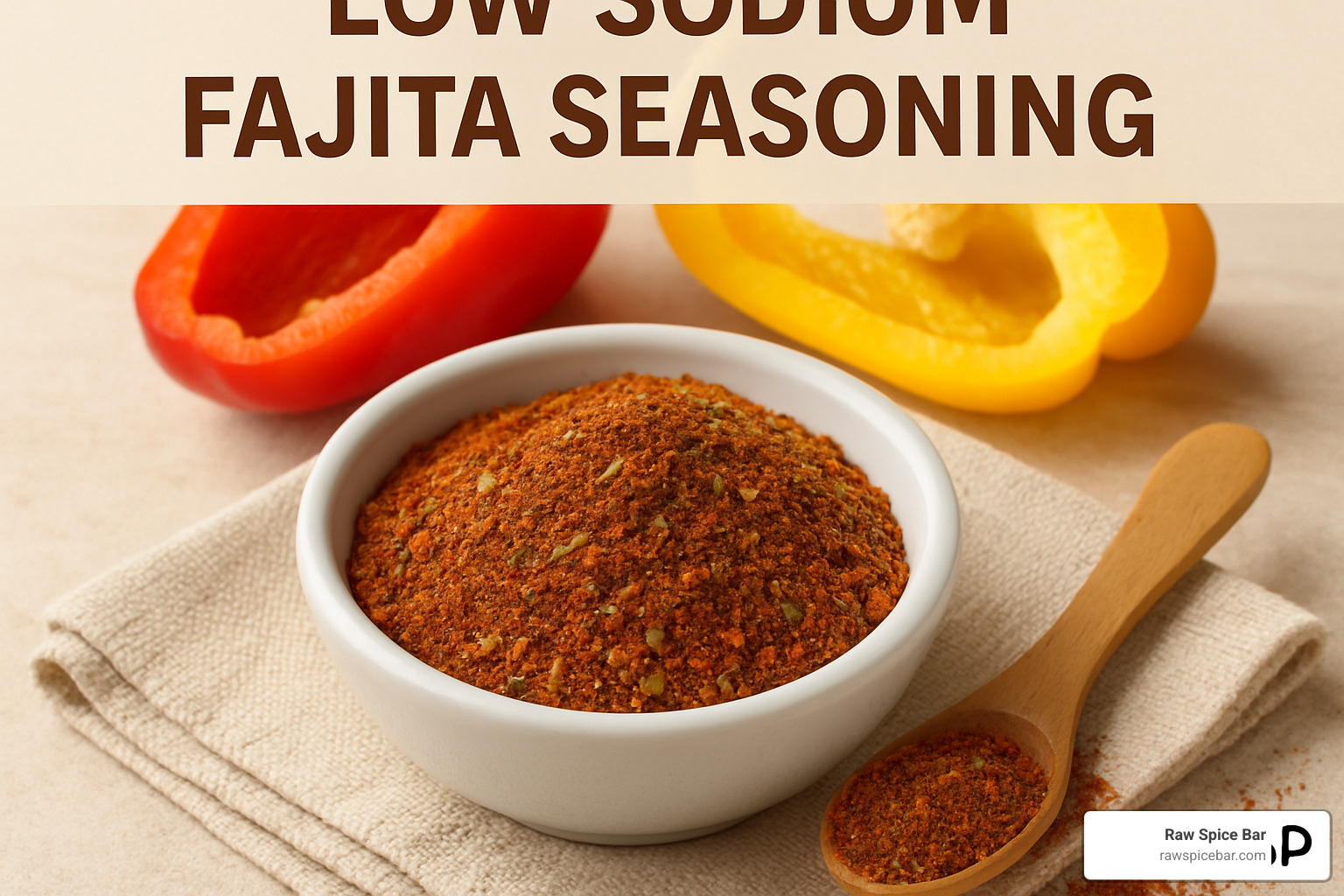
That store-bought packet packs a whopping 300 mg of sodium in just a 2-teaspoon serving. Even the ones claiming to be "reduced sodium" still contain more than 200 mg per serving. That's a lot of salt for such a small amount of seasoning!
But sodium is just the beginning of the story. Most commercial blends also contain MSG, which some people are sensitive to, along with artificial flavors and preservatives like silicon dioxide. Those innocent-looking packets often hide unnecessary sugars too, adding empty calories and potentially affecting your blood sugar levels.
Then there are the thickening agents – modified food starch, corn starch, or maltodextrin – which can be problematic if you're watching your carbs or have certain dietary restrictions.
The cost difference is eye-opening as well. While you'll spend $1-2 for a packet that makes about 4-6 servings, a homemade blend costs roughly $0.25-0.50 per equivalent serving. Plus, you probably already have most of the ingredients sitting in your spice cabinet!
At Raw Spice Bar, we're passionate about freshness in spice blends. Unlike those mass-produced packets that might sit on store shelves for months (or even years), our spices are blended in small batches to ensure you're getting the most vibrant flavors possible.
Reading Nutrition Labels Like a Pro
Becoming a nutrition label detective is essential when you're watching your sodium intake. Those labels can be tricky, and manufacturers know it.
First, always check the serving sizes. Many companies list unrealistically small serving sizes to make the sodium content appear lower. For fajita seasoning, a serving might be listed as just 1/4 or 1/2 teaspoon, but let's be honest – most recipes call for much more than that!
The % Daily Value (DV) is your friend here. It tells you what percentage of the recommended daily sodium intake (2,300 mg) is in one serving. When you see anything over 20% DV per serving, that's considered high.
Salt isn't sneaky just by itself – it hides behind aliases too. Watch for ingredients like monosodium glutamate (MSG), sodium bicarbonate, disodium phosphate, sodium nitrate, sodium benzoate, and even soy sauce. All of these contribute to your total sodium intake.
And don't be fooled by marketing terms. "Reduced sodium" products only need to contain 25% less sodium than the original version – which could still be quite high! It's like saying a mountain is "shorter" because you removed the top 25% – it's still a mountain.
By making your own low sodium fajita seasoning, you sidestep all these label-reading challenges completely.
Health Benefits of Low-Sodium Switch
Switching to a low sodium fajita seasoning isn't just about numbers on a nutrition label – it's about how you feel.
That puffy, bloated feeling after a salty meal? That's water retention, and less sodium means your body won't hold onto excess water. Your rings will fit better, and your face might look less puffy in the morning.
Your heart will thank you too. Lower sodium intake helps maintain healthy blood pressure levels, reducing strain on your entire cardiovascular system. Your kidneys, which work overtime to balance sodium levels in your body, will be under less stress with a lower-sodium diet.
There's also something wonderful that happens to your taste buds when you cut back on salt. Without overwhelming saltiness, you can actually taste the complex flavors of spices and herbs. Over time, your palate adjusts to lower sodium levels, allowing you to enjoy the natural flavors of food more fully. Many of my customers tell me they're surprised by how much more they taste after cutting back on salt.
A study published in the New England Journal of Medicine found that even modest reductions in sodium intake could prevent thousands of cases of cardiovascular disease annually. Something as simple as switching to a homemade low sodium fajita seasoning can be part of this positive dietary change.
The best part? You don't have to sacrifice flavor to get these benefits. In fact, many people find that once they break free from salt-dependency, they find a whole new world of taste sensations that were previously masked by excessive sodium.
DIY Guide: Low Sodium Fajita Seasoning
Creating your own low sodium fajita seasoning at home is surprisingly simple and incredibly rewarding. Not only will you cut down on unnecessary salt, but you'll also find a world of vibrant flavors that commercial mixes often mask with excessive sodium.
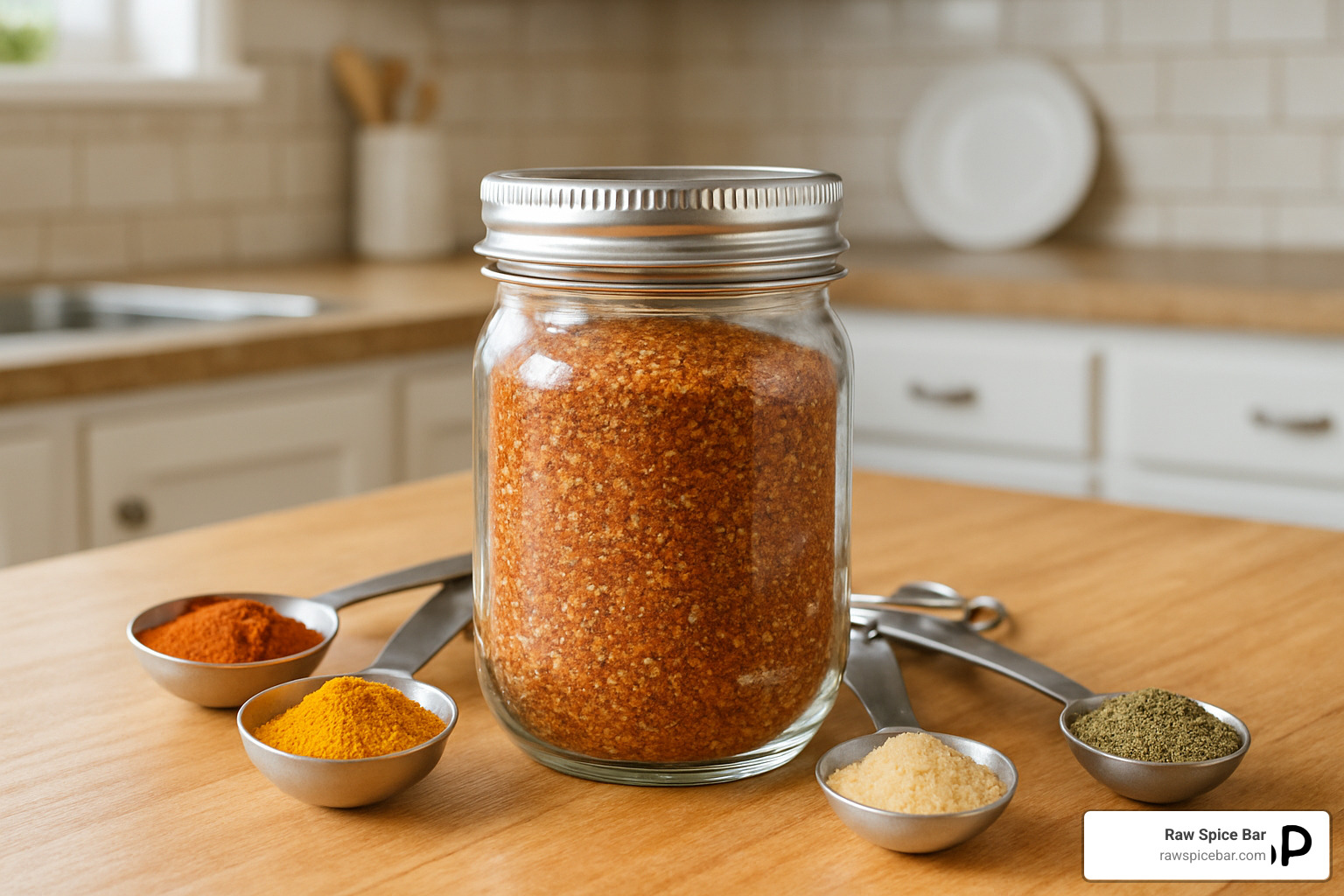
Key Ingredients for Low Sodium Fajita Seasoning
The magic of a great low sodium fajita seasoning comes from the harmonious blend of spices that each contribute something special to the mix.
The foundation starts with chili powder, which provides that earthy warmth and rich color we associate with Tex-Mex cuisine. Just be sure to check the label, as some commercial chili powders sneak in salt. Next comes cumin, the distinctive earthy spice that's non-negotiable in any fajita blend – I always recommend grinding whole seeds for a flavor that sings.
Paprika adds sweet pepper notes and that gorgeous color that makes your dishes Instagram-worthy. While regular paprika works beautifully, I sometimes reach for smoked paprika when I want that subtle hint of campfire that reminds me of outdoor cooking.
The aromatic duo of garlic powder and onion powder creates depth and savory notes – just double-check you're grabbing the powder versions, not their saltier cousins garlic salt and onion salt. A sprinkle of oregano brings herbal complexity (Mexican oregano is traditional, but Mediterranean works in a pinch), while black pepper ties everything together with its universal improvement of other flavors.
For those who enjoy some heat, cayenne pepper lets you control exactly how spicy your blend becomes. I find this particularly helpful when cooking for mixed groups – some like it hot, some definitely do not!
For adventurous cooks, consider adding ancho chile powder for smoky sweetness, ground coriander for citrusy brightness, or even a pinch of cocoa powder for depth without sweetness. If you miss the thickening power of store-bought mixes, a couple teaspoons of cornstarch works wonders for creating those silky fajita sauces.
At Raw Spice Bar, we're passionate about salt-free, preservative-free seasoning blends that let natural flavors shine through.
How to Make Low Sodium Fajita Seasoning Step-by-Step
Making your own low sodium fajita seasoning couldn't be easier. Here's my foolproof recipe that delivers maximum flavor with minimal sodium:
Ingredients: * 2 tablespoons chili powder (sodium-free) * 1 tablespoon ground cumin * 1 tablespoon paprika * 1 teaspoon garlic powder * 1 teaspoon onion powder * 1 teaspoon dried oregano * 1/2 teaspoon black pepper * 1/4 teaspoon cayenne pepper (adjust to taste) * Optional: 1-2 teaspoons cornstarch (as a thickener)
The process is wonderfully simple: make sure your measuring spoons are completely dry, then combine everything in a small bowl and whisk until well blended. Transfer your fragrant creation to an airtight glass container, label it with the date, and store in a cool, dark place.
This recipe yields about 5-6 tablespoons of seasoning, enough for several delicious meals. The entire batch contains only about 200-220 mg of sodium (from the natural sodium in the spices themselves), compared to a whopping 1,500+ mg in the same amount of store-bought mix. That's a difference your body will thank you for!
Customizing Heat & Flavor
One of the joys of making your own low sodium fajita seasoning is the ability to tailor it precisely to your taste preferences.
Heat levels are completely in your control. For a family-friendly mild version, reduce or completely skip the cayenne. Want to clear your sinuses? Double the cayenne or add some crushed red pepper flakes. I've found that gradual adjustments work best – you can always add more heat, but you can't take it away!
To brighten flavors without adding salt, try incorporating dried lime or lemon zest – about a teaspoon adds a wonderful citrus pop that wakes up the whole blend. A tiny pinch of cocoa powder (just 1/8 teaspoon) creates remarkable depth without any chocolate flavor – it's my secret weapon for complexity.
If you're really missing that mineral quality that salt provides, consider experimenting with potassium-based salt substitutes. Just be aware that some people detect a slight metallic aftertaste, and those with kidney issues or on certain medications should chat with their doctor first.
Spices vary in potency based on freshness and source. My grandmother always said spices are like personalities – some are bold right away, others need coaxing to reveal their character. Don't be afraid to adjust your blend after tasting it in a dish.
Storing & Shelf Life Hacks
Proper storage ensures your low sodium fajita seasoning maintains its vibrant flavor for months to come.
Glass containers are your best friend here – they don't absorb flavors or allow air exchange like plastic can. I learned this lesson the hard way after storing a potent curry blend in plastic, only to find my next batch of cinnamon-sugar mysteriously tasted like curry!
Keep your precious blend in a cool, dark cabinet away from your stove or oven. Heat, light, and moisture are the three enemies of spice freshness, gradually robbing your blend of its aromatic oils and flavor compounds.
Always mark the date on your container. While your blend won't become unsafe over time, it will gradually lose its punch. For optimal flavor, aim to use your blend within 6 months. I like to make smaller batches more frequently rather than one giant batch that sits half-used for a year.
If you're unsure about your blend's potency, try this simple freshness test: rub a small amount between your fingers and take a good sniff. If the aroma is bold and vibrant, you're good to go. If it's faint or dusty-smelling, it's time for a fresh batch.
At Raw Spice Bar, we're big believers in the "grind as needed" approach. While pre-ground spices are convenient, whole spices retain their essential oils (and thus their flavor) much longer – like keeping coffee beans whole until you're ready to brew.
Beyond Fajitas: Creative Uses & Dietary Tweaks
Your homemade low sodium fajita seasoning is a flavor powerhouse that deserves to break free from its traditional role. Think of it as your secret weapon in the kitchen – ready to transform ordinary dishes into something special without adding unnecessary salt.
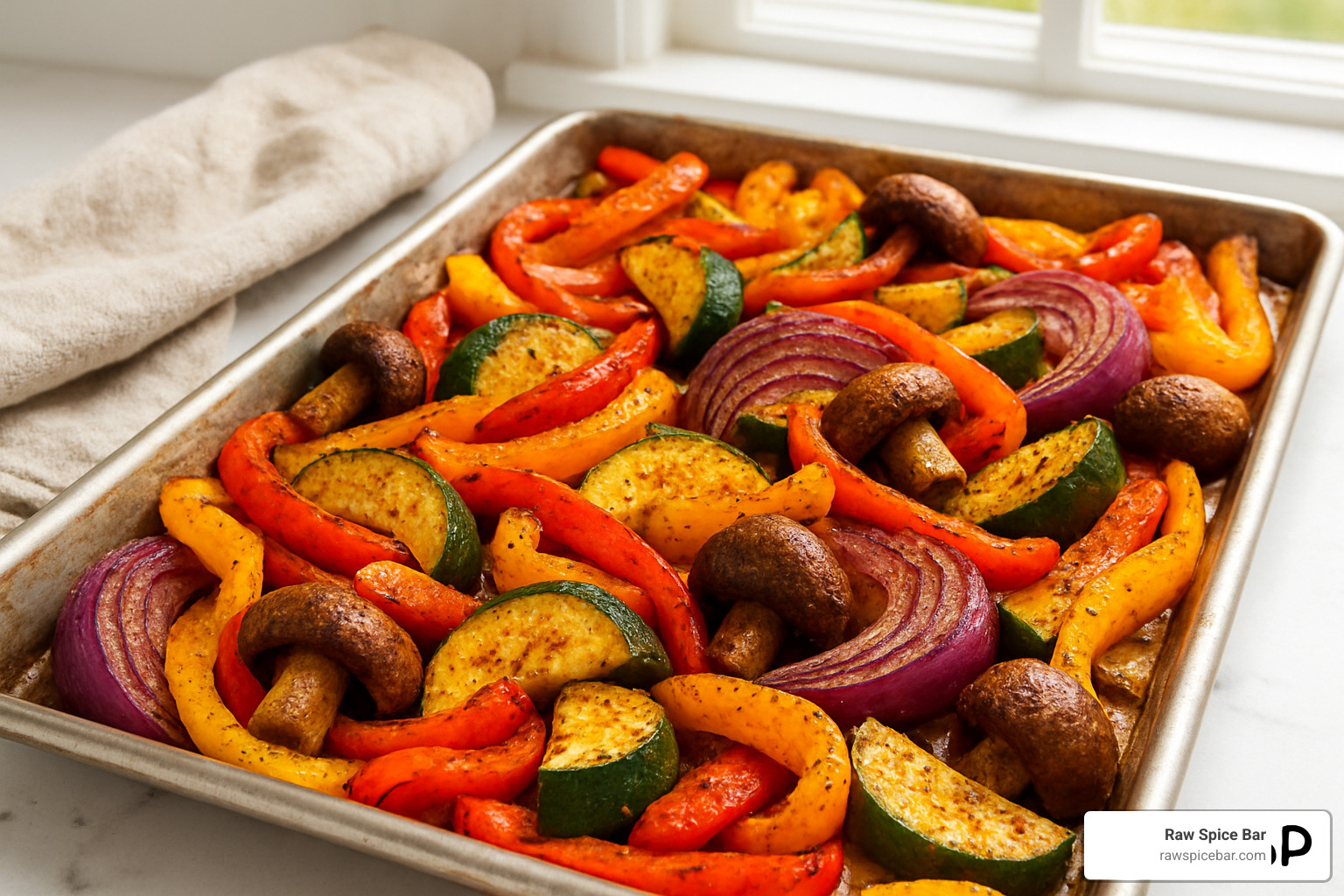
Ever tried roasting a colorful medley of bell peppers, zucchini, and mushrooms with a sprinkle of your blend? The spices caramelize slightly, creating an irresistible side dish that might just steal the spotlight from your main course. For a quick weeknight dinner, try rubbing the seasoning on chicken breasts before grilling – you'll get restaurant-quality flavor without the sodium overload.
On chilly evenings, a tablespoon stirred into homemade chicken soup or black bean chili works wonders, instantly adding that warm Tex-Mex depth. Even breakfast can benefit – a pinch in scrambled eggs with some diced peppers creates a satisfying start to your day. And don't overlook the humble popcorn – a light dusting of low sodium fajita seasoning with a squeeze of lime makes for an addictive snack that's perfect for movie night.
At Raw Spice Bar, we've found that this versatile blend is one of our favorites for spicing up roasted vegetables – the complex flavor profile complements everything from cauliflower to sweet potatoes.
Need to adapt for dietary restrictions? No problem! For those following a low-FODMAP diet, simply skip the onion and garlic powder, substituting a tiny pinch of asafoetida or the green parts of spring onions instead. The blend is naturally gluten-free (though always check that your individual spices weren't processed in facilities handling gluten if you have celiac disease).
Vegans can enjoy the full flavor experience by seasoning tofu or tempeh for plant-based fajitas that don't sacrifice an ounce of taste. And if you're following a keto lifestyle, you'll be pleased to know this blend is naturally low in carbs and perfect for your high-fat, moderate-protein meals.
Pairing with Low-Sodium Tortillas & Sides
Creating a complete low-sodium Mexican feast means thinking beyond just the seasoning. Soft corn tortillas make an excellent base, typically containing only 0-50 mg of sodium each – a fraction of what you'll find in most flour versions. For an even lighter option, crisp lettuce wraps add a refreshing crunch with zero sodium.
Your fajitas deserve equally thoughtful sides. Instead of salt-laden rice, try a bright cilantro lime version where fresh citrus and herbs provide the flavor punch. Homemade guacamole is another perfect partner – avocados are naturally low in sodium and high in potassium, making them an ideal choice for heart-healthy eating.
Fresh toppings lift the entire experience: a scatter of cilantro leaves, a squeeze of lime, diced avocado, or a dollop of plain Greek yogurt (a lighter stand-in for sour cream). These simple additions bring brightness and creaminess without the sodium overload of pre-packaged taco toppings.
By thoughtfully combining your low sodium fajita seasoning with these complementary ingredients, you create a meal that's not just better for your heart – it actually tastes better too, with clean, bright flavors that aren't masked by excessive salt.
Portion Guide: How Much Seasoning Per Pound
Finding the sweet spot with your homemade blend takes a little practice, but here's my rule of thumb: for chicken, beef, or shrimp, about 1-1.5 tablespoons per pound gives perfect coverage. Vegetables need a lighter touch – about 1 teaspoon per cup is usually just right.
Creating a quick marinade? Combine 1 tablespoon of your low sodium fajita seasoning with 2 tablespoons of olive oil and 2 tablespoons of lime juice for each pound of protein. This simple ratio creates a flavorful bath that tenderizes while it seasons.
Homemade blends pack more punch than store-bought versions – the flavors haven't faded away during months on a shelf. I always suggest starting conservatively; you can always add more, but you can't take it away once it's mixed in.
When I'm developing recipes at home, I've learned to consider the cooking method too. Foods cooked over high heat (like grilled skirt steak) can handle a bit more seasoning than gentler methods. The intensity of the other ingredients matters too – if your dish includes bold elements like lime juice or fresh chiles, you might want to dial back the seasoning slightly to maintain balance.
With a little attention to these details, your low sodium fajita seasoning will help you create consistently delicious meals that put flavor first while keeping sodium in check.
Frequently Asked Questions about Low Sodium Fajita Seasoning
Can I use salt substitutes like potassium chloride?
Wondering about salt substitutes in your low sodium fajita seasoning? You absolutely can use potassium-based alternatives, but there are a few things worth knowing before you sprinkle.
Some folks notice a slight metallic aftertaste with potassium chloride that might take getting used to. It's like switching from regular soda to diet – there's an adjustment period for your taste buds!
While potassium chloride is a wonderful option for many people looking to reduce sodium, it's not right for everyone. If you have kidney issues or take certain medications (especially potassium-sparing diuretics, ACE inhibitors, or ARBs), please chat with your doctor first. Your kidneys handle potassium differently than sodium, and too much can be problematic for some people.
When using these substitutes, start with half the amount you'd normally use with regular salt. You can always add more, but you can't take it away! Try mixing it with bright flavors like lime zest or additional herbs to help mask any metallic notes you might detect.
In our experience at Raw Spice Bar, most home cooks adapt quite happily to lower-sodium seasonings without needing substitutes at all – it's all about balancing those other flavor components to create depth and satisfaction.
How long does homemade seasoning really stay fresh?
Your homemade low sodium fajita seasoning should maintain its vibrant flavor for about 6 months when stored properly, but several factors can influence its shelf life.
Think of your spice blend like a good bottle of perfume – it needs the right storage conditions to preserve those aromatic compounds. Cool, dark, and dry environments are your friend, while heat, light, and humidity are definite enemies. That cabinet right above your stove? Probably not the best spot!
Glass containers with tight-fitting lids are far superior to plastic for preserving those precious flavors. They don't absorb odors or allow air exchange the way plastic can. Those cute little mason jars aren't just for Instagram photos – they're genuinely better for your spices!
The freshness of your starting ingredients matters too. If you began with vibrant, aromatic spices, your blend will naturally last longer than if you used that chili powder that's been sitting in your pantry since your last apartment.
Don't worry – your blend won't suddenly become unsafe after 6 months. It will gradually fade in potency, like a song that gets quieter over time. If you open the container and have to stick your nose right in to smell anything, it's time for a fresh batch.
Some clever cooks keep small amounts at room temperature for daily use and freeze the rest to extend shelf life. While research on spice shelf life suggests ground spices can technically last 2-3 years, their flavor peak is much shorter. For the best culinary experience, refreshing your blends twice yearly is a good rule of thumb.
What's the best way to reduce heat without losing flavor?
Not everyone enjoys setting their taste buds on fire! If you want all the flavor of low sodium fajita seasoning without the heat, I've got some simple adjustments for you.
The simplest approach is to completely skip the cayenne pepper – it's the main heat source in most fajita seasonings. You'll still get plenty of flavor from the other ingredients. If you find chili powder too spicy as well, try cutting it in half and replacing the difference with additional paprika, which gives you color and flavor without significant heat.
Ancho chili powder is another fantastic option – it delivers wonderful chile flavor with very minimal heat. It's like getting all the personality without the bite!
You can also lean more heavily on the herbs. Try increasing the oregano or adding a bit of thyme to compensate for any reduced spices. These aromatic herbs contribute wonderful complexity without any heat.
A little acid can work wonders too. A squeeze of lime juice or a bit of lime zest brightens flavors dramatically, making the whole blend taste more vibrant without adding spiciness.
Here's a little chef's secret: a tiny pinch of sugar (just 1/8 teaspoon in your batch) can balance flavors and actually reduce your perception of heat. It's not enough to make things sweet – just enough to round everything out.
And don't forget your serving companions! Pairing your fajitas with cooling elements like avocado, a dollop of plain Greek yogurt, or an extra squeeze of lime can help balance any remaining heat in the finished dish.
The goal isn't to completely transform the seasoning but to maintain that essential fajita character while adjusting it to your personal comfort level. With these tweaks, you can enjoy all the bold flavors of Tex-Mex cuisine without reaching for the water glass after every bite!
Conclusion & Next Steps
Creating your own low sodium fajita seasoning isn't just a fun kitchen project—it's a meaningful step toward better health without saying goodbye to the flavors you love. By making this simple switch in your cooking routine, you're taking control of your sodium intake, eliminating those unnecessary additives, and crafting a seasoning blend that perfectly matches your taste preferences.
The beauty of homemade spice blends is how they empower you as a home cook. When you mix your own seasonings, you're not just following a recipe—you're developing a deeper understanding of how flavors work together. That chili powder brings earthiness, the cumin adds warmth, and the paprika contributes that gorgeous color and sweet pepper notes—all without relying on salt as a flavor crutch.
At Raw Spice Bar, we've seen how quality spices can transform ordinary meals into extraordinary experiences. Our passion for salt-free seasoning blends comes from knowing that everyone deserves delicious food, regardless of dietary restrictions.
Reducing sodium doesn't mean reducing joy in eating. In fact, many people find that after adjusting to lower-salt foods, they begin to appreciate the complex, nuanced flavors of spices even more. Your taste buds actually become more sensitive to the wonderful aromatics and subtle notes that were previously overwhelmed by excessive salt.
I encourage you to keep experimenting with your low sodium fajita seasoning. Try it on scrambled eggs tomorrow morning. Toss it with some chickpeas before roasting them for a crunchy snack. Sprinkle it on popcorn for movie night. The versatility of this blend means you'll never get bored.
If you're enjoying the journey of finding how spices can transform your cooking while supporting your health goals, consider exploring more global flavors through our monthly spice subscription. Each month brings new culinary trips right to your doorstep, complete with recipes and the stories behind the blends.
Your path to healthier eating shouldn't feel like a sacrifice. With the right spices and a bit of creativity, you can enjoy all the vibrant flavors of global cuisines while taking good care of your heart and overall wellbeing. Here's to spicing up your life—not your sodium levels!



